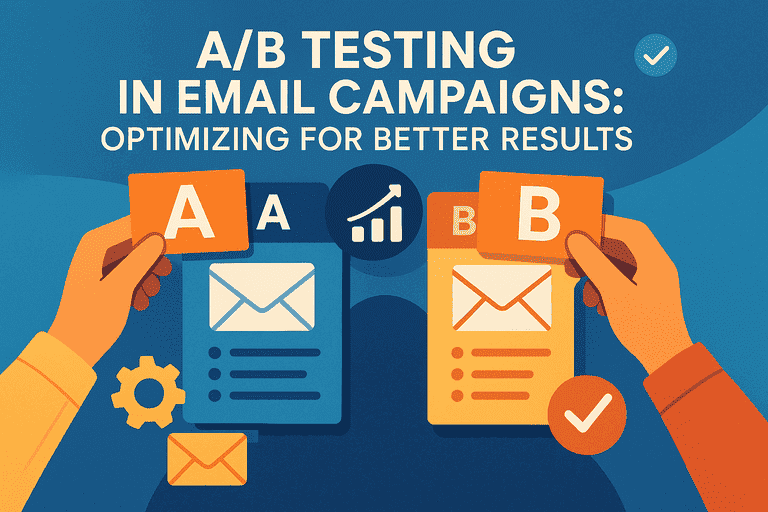Imagine sending out two nearly identical emails — but one leads to 20% more clicks than the other. That's the power of A/B testing. It's not just a tactic; it's a game-changer for small businesses looking to get the most out of every email they send. In today's crowded inboxes, optimizing your emails isn't optional — it's essential.
In this guide, I'll break down everything you need to know about A/B testing in email campaigns, from what it is to how you can start today — even with a small list and budget.
What Is A/B Testing in Email Marketing?

A/B testing (also known as split testing) is the process of sending two versions of an email to a small percentage of your list to see which one performs better — then sending the winning version to the rest.
In other words:
- Version A might have one subject line
- Version B has another
- You compare results like open rate, click-throughs, or conversions
This data-driven approach takes the guesswork out of email marketing.
Why Does A/B Testing Matter for SMBs?
Higher ROI
Test results help you improve performance without increasing spend.
Better Understanding
Learn what language, visuals, and offers resonate with your audience.
Competitive Edge
While larger brands test frequently, many SMBs don't — giving you an edge.
Data over Intuition
Remove guesswork and rely on measurable outcomes.
What Can You Test in an Email Campaign?
Email Elements
- Subject lines (different tones, emojis, questions)
- Preheader text (preview text)
- Email content and structure
- CTA buttons (color, placement, wording)
Delivery Options
- Sender name (company vs. person)
- Send time/day
- Images vs. no images
- Visual-heavy vs. minimalist design
Tip: Test only one variable at a time to understand what's actually making the difference.
How to Set Up an Effective A/B Test (Step-by-Step)
Define a Clear Goal
What are you optimizing for? Open rate, click-through rate, or conversions?
Choose One Variable
Pick only one element to test — like subject line or CTA button.
Create Two Versions
Craft version A and version B with only that one variable changed.
Segment Your Audience
Send each version to a small, randomly selected portion of your email list (e.g., 10% each).
Run the Test
Let the test run long enough to gather meaningful data — ideally 4–24 hours.
Analyze the Results
Identify the winning version based on your chosen metric.
Send to the Remaining List
Send the better-performing version to the rest of your list for optimal results.
Common A/B Testing Mistakes to Avoid
-
Testing Multiple Variables
Testing too many variables at once makes it impossible to identify what's working.
-
Small Sample Size
Using sample sizes that are too small can lead to unreliable results.
-
Rushing Results
Declaring a winner too early without sufficient data.
-
Ignoring Statistical Significance
Not considering whether results are statistically meaningful.
-
Not Applying Learnings
Failing to use insights from tests in future campaigns.
Real-World Example: A/B Testing in Action
A Small Bakery's Success Story
Subject Line A:
"Freshly Baked: Try Our New Cinnamon Rolls"
Subject Line B:
"You Deserve a Warm Treat This Morning"
Results:
- Subject line B got 38% more opens
- 22% more clicks than version A
Lesson: Emotion and emojis can drive engagement — but it depends on your audience. That's why testing matters.
Top Tools for Email A/B Testing
Mailchimp
PopularBuilt-in A/B testing features for beginners.
Klaviyo
Perfect for eCommerce SMBs.
MailerLite
Beginner-friendly interface.
ActiveCampaign
Automation + split testing.
HubSpot
All-in-one for growing teams.
Frequently Asked Questions
How big should my test audience be?
Aim for at least 10–20% of your list. Too small, and results won't be reliable.
How long should I run my test?
Run it long enough to reach statistical significance — usually at least 4 hours.
Can I test more than one thing at a time?
Technically yes, but it's not recommended unless you're doing multivariate testing.
What's a good A/B test goal for beginners?
Start with subject lines. They're easy to change and can quickly boost open rates.
Is A/B testing worth it for small lists?
Absolutely. Even with 500 subscribers, small improvements add up over time.
Optimize Smarter, Not Harder
The best email marketers aren't the ones who always get it right — they're the ones who test, learn, and improve. A/B testing gives you real insights into what your audience wants and helps you deliver better results with every send.
Whether you're just starting or looking to fine-tune your strategy, remember: small tests can lead to big wins.
So — what's your first A/B test going to be?

